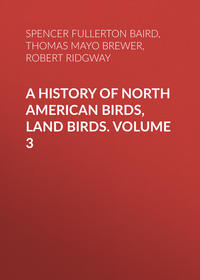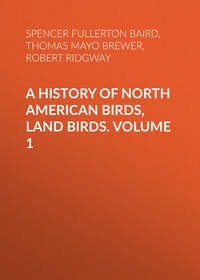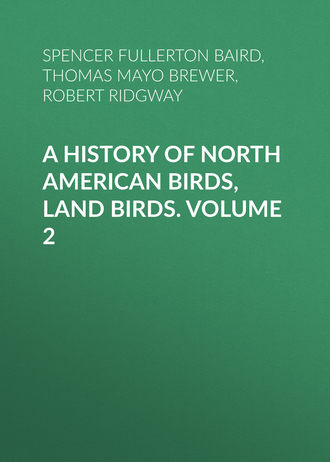 полная версия
полная версияA History of North American Birds, Land Birds. Volume 2
This Finch, hitherto assumed to be an exclusively southeastern species, has recently been detected by Mr. Ridgway in Southern Illinois, where it is a summer resident, and where it breeds, but is not abundant. It inhabits old fields, where, perched upon a fence-stake or an old dead tree, it is described as chanting a very delightful song. It was first taken on the 12th of July, 1871, on the road about half-way between Mount Carmel and Olney. The bird was then seen on a fence, and its unfamiliar appearance and fine song at once attracted his notice as he was riding by. As several were heard singing in the same neighborhood, it seemed common in that locality, and as a young bird was taken in its first plumage there is no doubt that it is a regular summer visitant of Southern Illinois, and breeds there. Mr. Ridgway speaks of its song as one of the finest he has ever heard, most resembling the sweet chant of the Field Sparrow, but is stronger, and varied by a clear, high, and very musical strain. He describes its song as resembling the syllables thééééééé-til-lūt, lūt-lūt, the first being a very fine trill pitched in a very high musical key, the last syllable abrupt and metallic in tone.
The food of this species, Dr. Bachman states, consists of the seeds of grasses, and also of coleopterous insects, as well as of a variety of the small berries so abundant in that part of the country. He speaks of its flight as swift, direct, and somewhat protracted, and adds that it is often out of sight before it alights.
Dr. Coues did not meet with this Sparrow in South Carolina, but he was informed by Professor Leconte that it occurs about Columbia and elsewhere in the State, frequenting open pine woods and old dry fields.
Dr. Bryant met with its nest in Florida, April 20. It was similar, in construction, to that of the Savannah Sparrow, and contained five eggs. It was the only Sparrow found by him in the pine barrens near Enterprise, and was only seen occasionally, when it was a very difficult bird to shoot, as it runs round in the grass more like a mouse than a bird, and will not fly until almost trodden on, then moving only a few feet at a time.
The nests of this bird, found by Dr. Bryant in Florida and by Dr. Gerhardt in Northern Georgia, were all placed upon the ground and concealed in tufts of thick grass, and constructed entirely of coarse wiry grasses, with no other lining than this material. The eggs, four in number, are of a pure, almost brilliant white, of a rounded oval shape, and measure .74 by .60 of an inch.
Peucæa æstivalis var. arizonæ, RidgwayARIZONA SPARROWPeucæa cassini, Baird, Birds N. Am. 1858, 486. (Los Nogales specimen.)
Sp. Char. (6,327 ♂, Los Nogales, Northern Sonora, June, C. B. Kennerly.) Similar to P. æstivalis, but paler; wings and tail longer. Above light chestnut, all the feathers margined and tipped with bluish-gray, but the reddish prevailing. Interscapular and crown feathers with a narrow streak of black, those on crown indistinct. Beneath dull white, tinged with ashy-ochraceous across the breast and along the sides; crissum pale ochraceous. An obsolete light superciliary, and narrow dusky maxillary stripe. Bend of wing yellow; lesser coverts tinged with greenish-yellow. Length, 6 inches; wing, 2.65; tail, 3.00; bill, .32 from nostril, .25 deep at base; tarsus, .80; middle toe, .63.
Hab. Los Nogales, Sonora, and Southern Arizona.
This race has a considerable resemblance to P. æstivalis, but differs in some appreciable points. The brown of the upper parts is paler, and the ashy edging to the feathers appears rather less extensive. The dark brown blotches on the back are of greater extent, the black streaks on the back confined to a mere streak along the shaft. There is less of an olive tinge across the breast.
The proportions of the present race differ more from those of æstivalis than do the colors, the bill being more slender, and the wings and tail considerably longer.
The resemblance to P. botterii (= æstivalis, var. botterii) of Sclater, from Middle Mexico (Orizaba, Colima, etc.), is very close; the difference being greater in the proportions than in the colors, the latter having a shorter wing and tail, with thicker bill, as in var. æstivalis. In botterii there is rather a predominance of the black over the rufous in the streaks above.
Habits. This, in its general habits, nesting, eggs, etc., probably resembles the variety æstivalis.
Peucæa cassini, BairdCASSIN’S SPARROWZonotrichia cassini, Woodhouse, Pr. A. N. Sc. Ph. VI, April, 1852, 60 (San Antonio). Passerculus cassini, Woodhouse, Sitgreaves’s Rep. Zuñi and Colorado, 1853, 85; Birds, pl. iv. Peucæa cassini, Baird, Birds N. Am. 1858, 485, pl. iv, f. 2.—Heermann, X, c, p. 12, pl. iv, f. 2.—Cooper, Orn. Cal. 1, 219 (not from Cal.).
Sp. Char. (6,329 ♂, Texas; compared with type of species.) Ground-color of upper parts grayish-ash; the middle portion of each feather dull brown, in the form of a blotch, and with a black shaft-streak, the latter becoming modified on scapulars, rump, and upper tail-coverts, into transverse spots, those on the upper tail-coverts being large and conspicuous, and in the form of crescentic spots, the terminal margin of the feathers being lighter ashy in sharp contrast. Middle tail-feathers clear ashy, with a sharply defined shaft-streak of blackish, throwing off obsolete, narrow, transverse bars toward the edge; rest of tail clear dusky-brown, the lateral feather with whole outer web, and margin of the inner, dull white, all, except the intermediate, with a large, abruptly defined, terminal space of dilute brown (decreasing in size from the outer), the margin whitish. Upper secondaries broadly and sharply margined along both edges with dull ashy-white, the enclosed portion being clear dusky brown, intensified where adjoining the whitish. A very obsolete superciliary stripe of ashy, becoming whitish over the lore; auriculars more dingy, but without distinct stripe along upper edge. An uninterrupted but indistinct “bridle” along sides of throat. Lower parts dull white, without any ochraceous, but with a very faint ashy tinge ever the jugulum; flanks with broad, somewhat blended streaks of mixed brownish and dusky. Bend of wing edged with light yellow. Wing, 2.55; tail, 2.80; bill, .28 from nostril and .23 deep; tarsus, .68; middle toe, .55.
Young. (45,277, Laredo, Texas, June 28.) Very similar, but with a few drop-shaped streaks of dark brown on the jugulum and along sides. The feathers above have a more appreciable terminal border of buff.
Hab. Rio Grande region of Southern Middle Province; Kansas, breeding (Allen). San Antonio, Texas, summer (Dresser, Ibis, 1865, 489; eggs); ? Orizaba, temp. reg. (Sum. M. B. S. I, 551).
In the Birds of North America, the specimen characterized on p. 637 of the present work as æstivalis, var. arizonæ, was referred to P. cassini, those specimens which are here retained as such being considered as in quite immature plumage. A more recent examination of additional material, however, has compelled us to change our view. In consequence of the similarity of the specimen in question to æstivalis, as noted in the article referred to above, the general acceptation of the name cassini has been that of a term designating a variety of the common species; but we have as the result of the investigation in question found it necessary to retain under the head of “cassini” only the typical specimens from the Rio Grande region, and refer the supposed aberrant specimen to æstivalis. In this Los Nogales specimen we find existing such differences in proportions and colors as are sufficient to warrant our bestowing upon it a new name, and establishing it as the Middle Province race of æstivalis, in this way connecting the South Atlantic and Mexican races (var. æstivalis and var. botterii) by a more similar form than the P. cassini, which must be set apart as an independent form,—in all probability a good species. Several facts are favorable to this view. First, we have of the P. cassini specimens which are beyond question in perfect adult plumage, and others which are undoubtedly immature; they differ from each other only in such respects as would be expected, and agree substantially in other characters, by which they are distinguished from the different styles of æstivalis. Secondly, the region to be filled by a peculiar race of æstivalis is represented by the var. arizonæ, which is undoubtedly referable to that species; thus we have in one province these two different forms, which therefore are probably distinct.
The present bird is hardly less distinct from the races of æstivalis than is ruficeps; and we would be as willing to consider all the definable forms presented in the synopsis as varieties of a single species, as to refer the present bird to æstivalis.
Habits. This Finch, in its general appearance, as well as in respect to habits, nesting, and eggs, is quite similar to Bachman’s Finch. It was first met with by Dr. Woodhouse, in the expedition to the Zuñi River, when he found it in Western Texas. He shot it on the prairies near San Antonio, on the 25th of April, 1851, mistaking it for Passerculus savanna, which, in its habits, it seemed to him very much to resemble, but upon examination it was found to be totally distinct.
Dr. Heermann afterwards, being at Comanche Springs in Texas, had his attention attracted by the new note of a bird unfamiliar to him. It was found, after some observation, to proceed from this species. He describes it as rising with a tremulous motion of its wings some twenty feet or more, and then descending again, in the same manner, to within a few yards of the spot whence it started, and as accompanying its entire flight with a lengthened and pleasing song. The country in that neighborhood is very barren, covered with low stunted bushes, in which the bird takes refuge on being alarmed, gliding rapidly through the grass and shrubbery, and very adroitly and effectually evading its pursuer. He observed them during four or five days of the journey of his party, and after that saw no more of them. They seemed, at the time, to be migrating, though their continued and oft-repeated song also showed that they were not far from readiness for the duties of incubation.
The Peucæa cassini is said, by Mr. Sumichrast, to be a resident species in the valley of Orizaba, in the State of Vera Cruz, Mexico, and to be generally distributed throughout the temperate region of that district. It is very probable, however, that he has in view the Mexican race of P. æstivalis (var. botterii), and not the present species.
Mr. J. A. Allen, who considers this bird only a western form of P. æstivalis, mentions (Am. Naturalist, May, 1872) finding it quite frequently near the streams in Western Kansas, where its sweetly modulated song greets the ear with the first break of dawn, and is again heard at night till the last trace of twilight has disappeared. Mr. Allen also states, in a letter, that this bird was “tolerably common along the streams near Fort Hays, but very retiring, singing mostly after nightfall and before sunrise, during the morning twilight. When singing, it had the habit of rising into the air. I shot three one morning thus singing, when it was so dark I could not find the birds. The one I obtained does not differ appreciably from specimens from Mr. Cassin’s collection, labelled by him Peucæa cassini, collected in Texas.”
Mr. Ridgway regards this record of the manners of this bird, while singing, as indicating a specific difference from P. æstivalis. The latter, in Southern Illinois, has never been heard by him to sing at night, or in the morning, nor even on the wing; but in broad midday, in the hottest days of June, July, and August, he often heard them singing vigorously and sweetly, as they perched upon a fence or a dead tree in a field, exactly after the manner of our common Spizella pusilla.
Among Dr. Heermann’s notes, quoted by Mr. Dresser, is one containing the statement that he found this species not rare on the prairies near the Medina River, in Texas, where it breeds. Mr. Dresser also states that when at Howard’s Ranche, early in May, he found this bird by no means uncommon. He confirms Dr. Heermann’s account, that it is easily distinguished as it rises in the air, from a bush, with a peculiar fluttering motion of the wings, at the same time singing, and then suddenly dropping into the bushes again. He adds that, in his absence, Dr. Heermann procured the eggs of this species on the Medina, and while he was himself travelling in July towards Loredo, he found a nest which he was fully confident belonged to this bird. It was placed in a low bush not above a foot from the ground, and in its construction resembled that of the Poospiza bilineata. The eggs were three in number, pure white, closely agreeing with those taken by Dr. Heermann, and larger and more elongated than those of the bilineata.
An egg of this species, taken in Texas by Dr. H. R. Storer, the identification of which, however, was incomplete, is more oblong than the eggs of P. æstivalis, and smaller, measuring .72 by .58 of an inch. It is pure white also.
Peucæa ruficeps, BairdRUFOUS-CROWNED SPARROWAmmodromus ruficeps, Cassin, Pr. A. N. Sc. VI, Oct. 1852, 184 (California).– Ib. Illust. I, V, 1854, 135, pl. xx. Peucæa ruficeps, Baird, Birds N. Am. 1858, 486.—Cooper, Orn. Cal. 1, 1870, 218.
Sp. Char. Above brownish-ashy. The crown and nape uniform brownish-chestnut, the interscapular region and neck with the feathers of this color, except around the margins. A superciliary ashy stripe, whiter at the base of the bill. Beneath pale yellowish-brown, or brownish-yellow, darker and more ashy across the breast and on the sides of body; middle of belly and chin lighter; the latter with a well-marked line of black on each side. Edge of wing white. Under tail-coverts more rufous. Legs yellow. Length, 5.50; wing, 2.35; tail, 2.85.
Hab. Coast of California, to Mexico; ? Oaxaca, March (Scl. 1859, 380); ? Vera Cruz, temperate region; resident (Sum. M. B. S. I, 552).
This plainly colored species has the bill rather slender; tail rather long, and considerably rounded; the outer feathers .40 of an inch shorter than the middle; the feathers soft, and rounded at the tip. The wing is short; the primaries not much longer than the tertials; the second, third, fourth, and fifth nearly equal; the first scarcely longer than the secondaries.
There is a blackish tinge on the forehead, separated by a short central line of white, as in Spizella socialis. The eyelids are whitish, and there is a short black line immediately over the upper lid. There is a faint chestnut streak back of the eye. The chestnut of the nape is somewhat interrupted by pale edgings. The blotches on the back melt almost insensibly into the colors of the margins of the feathers. The outer edges of the secondaries and tertials, and the outer surface of the tail, are yellowish-rusty.
This bird is similar in general appearance to the P. æstivalis, but has the head above more continuous chestnut; the black cheek-stripe more distinct, and the edge of wing whitish, not yellow, the bill more slender. A Mexican specimen has a stouter bill.
The P. boucardi of Sclater (= ruficeps, var. boucardi; see table, p. 634), from Mexico, is exceedingly similar, it being very difficult to present the differences in a diagnosis. This trouble is partly the result of the insufficient series at our command, for there are such different combinations of colors, according to the season, that it is almost impossible to select the average characters of two definable forms.
Habits. This species was first described, in 1852, by Mr. Cassin, from a specimen obtained in California by Dr. Heermann. Very little is known as to its history, and it appears to have been generally overlooked by naturalists who have studied the ornithology of that State. The extent of its distribution or of its numbers remains unknown,—a circumstance due undoubtedly to the nature of the country which it frequents.
Dr. Heermann states that in the fall of 1851 he shot on the Cosumnes River a single specimen of this bird from among a large flock of Sparrows of various kinds. In the spring of the following year, among the mountains, near the Calaveras River, he found it quite abundant. It was then flying in pairs, engaged in picking grass-seed from the ground, and when started it never extended its flight beyond a few yards. Its notes, in their character, reminded him of the ditty of our common little Chipping Sparrow (Spizella socialis). He obtained several specimens. Its flight seemed feeble, and when raised from the ground, from which it would not start until almost trodden on, it would fly but a short distance, and almost immediately drop again into the grass.
Dr. Cooper has only met with this species on Catalina Island, in June, where a few kept about the low bushes, feeding on the ground. They were very difficult even to get a sight of. He heard them sing a few musical notes, that reminded him of those of the Cyanospizæ. They flew only a short distance, and in their habits reminded him of the Melospizæ. Their favorite places of resort he supposes to be pine woods, as in the eastern species.
The fact that this species has been found by Mr. Sumichrast to be a permanent resident throughout all the temperate regions of Vera Cruz is a very interesting one, and is suggestive of different manners and habits from those supposed to belong to it as a bird allied with the Ammodrami. They are abundant, and breed there, as in the United States, but nothing is given throwing any positive light upon their general habits.
Genus EMBERNAGRA, LessonEmbernagra, Lesson, Traité d’Ornith., 1831 (Agassiz). (Type, Saltator viridis, Vieillot.)
Gen. Char. Bill conical, elongated, compressed; the upper outline considerably curved, the lower straight; the commissure slightly concave, and faintly notched at the end. Tarsi lengthened; considerably longer than the middle toe. Outer toe a little longer than the inner, not reaching quite to the base of the middle claw. Hind toe about as long as the middle without its claw. Wings very short, and much rounded; the tertials nearly equal to the primaries; the secondaries a little shorter; the outer four primaries much graduated, even the second shorter than any other quill. The tail is moderate, about as long as the wings, much graduated; the feathers rather narrow, linear, and elliptically rounded at the end; the outer webs more than usually broad in proportion to the inner, being more than one third as wide. The upper parts are olive-green, the under whitish.
The position of this genus is a matter of considerable uncertainty. On some accounts it would be better placed among the Spizinæ.
There are numerous tropical species of this genus; none of them are nearly allied, however, to the single North American species.
Embernagra rufivirgata, LawrenceTEXAS SPARROWEmbernagra rufivirgata, Lawrence, Ann. N. Y. Lyc. V, May, 1851, 112, pl. v, f. 2 (Texas).—Sclater, Pr. Zoöl. Soc. 1856, 306.—Baird, Birds N. Am. 1858, 487, pl. lv. f. 2.—Ib. Mex. Bound. II, Birds, 16, pl. xvii, f. 2. Zonotrichia plebeja, Licht. Bon. Comptes Rend. 43, 1856, 413.
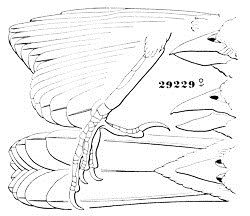
Embernagra rufivirgata, Lawr.
29229 ♀
Sp. Char. Above uniform olivaceous-green. A stripe on each side of the head, and one behind the eye, dull brownish-rufous, an ashy superciliary stripe whiter anteriorly. Under parts brownish-white, tinged with yellowish posteriorly, and with olivaceous on the sides; white in the middle of the belly. Edge of wing, under coverts, and axillaries bright yellow. Young with the head-stripes obsolete. Length, 5.50; wing, 2.60; tail, 2.70.
Hab. Valley of the Rio Grande, and probably of Gila, southward; Mazatlan, Mexico. Oaxaca, April (Scl. 1859, 380); Cordova; Vera Cruz, temperate and hot regions, breeding (Sum. M. B. S. I, 551); Yucatan (Lawr. IX, 201).
In this species the bill is rather long; the wings are very short, and much rounded; the tertials equal to the primaries; the secondaries rather shorter; the first quill is .65 of an inch shorter than the seventh, which is longest. The tail is short; the lateral feathers much graduated; the outer half an inch shorter than the middle.
All the Mexican specimens before us have the bill stouter than those from the Rio Grande of Texas, the stripes on the head apparently better defined. The back is darker olive; the flanks brighter olive-green, not olive-gray, the wings are apparently shorter. The series is not sufficiently perfect to show other differences, if any exist.
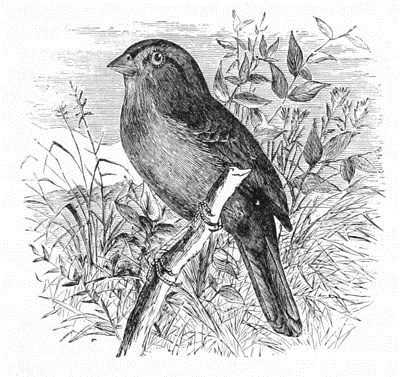
Embernagra rufivirgata.
Habits. In regard to the habits and distribution of this species we are entirely without any information, other than that it has been met with in the valley of the Rio Grande, and at various places in Mexico. Specimens were obtained at New Leon, Mexico, by Lieutenant Couch, and at Ringgold Barracks, in Texas, by Mr. J. H. Clark. The season when these birds were met with is not indicated by him.
It is stated by Mr. Sumichrast that this species is found throughout both the temperate and the hot districts of the State of Vera Cruz, Mexico. He also mentions that he has found this bird in localities quite remote from each other, and belonging both to the hot and to the temperate regions. In the latter it is found to the height of at least four thousand feet.
This species was met with by Mr. Boucard, during the winter months, at Plaza Vicente, in the hot lowlands of the State of Oaxaca, Mexico.
Subfamily PASSERELLINÆ
Char. Toes and claws very stout; the lateral claws reaching beyond the middle of the middle one; all very slightly curved.
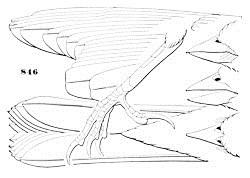
Passerella iliaca.
846
Bill conical, the outlines straight; both mandibles equal; wings long, longer than the even tail or slightly rounded, reaching nearly to the middle of its exposed portion. Hind claw longer than its digit; the toe nearly as long as the middle toe; tarsus longer than the middle toe. Brown above, either uniformly so or faintly streaked; triangular spots below.
This section embraces a single North American genus, chiefly characterized by the remarkable elongation of the lateral claws, as well as by the peculiar shape and large size of all the claws; the lateral, especially, are so much lengthened as to extend nearly as far as the middle. The only approach to this, as far as I recollect, among United States Conirostres, is in Pipilo megalonyx, and Xanthocephalus icterocephalus.
Genus PASSERELLA, SwainsonPasserella, Swainson, Class. Birds, II, 1837, 288. (Type, Fringilla iliaca, Merrem.)
Gen. Char. Body stout. Bill conical, not notched, the outlines straight; the two jaws of equal depth; roof of upper mandible deeply excavated, and vaulted; not knobbed. Tarsus scarcely longer than the middle toe; outer toe little longer than the inner, its claw reaching to the middle of the central one. Hind toe about equal to the inner lateral; the claws all long, and moderately curved only; the posterior rather longer than the middle, and equal to its toe. Wings long, pointed, reaching to the middle of the tail; the tertials scarcely longer than secondaries; second and third quills longest; first equal to the fifth. Tail very nearly even, scarcely longer than the wing. Inner claw contained scarcely one and a half times in its toe proper.
Color. Rufous or slaty; obsoletely streaked or uniform above; thickly spotted with triangular blotches beneath.




